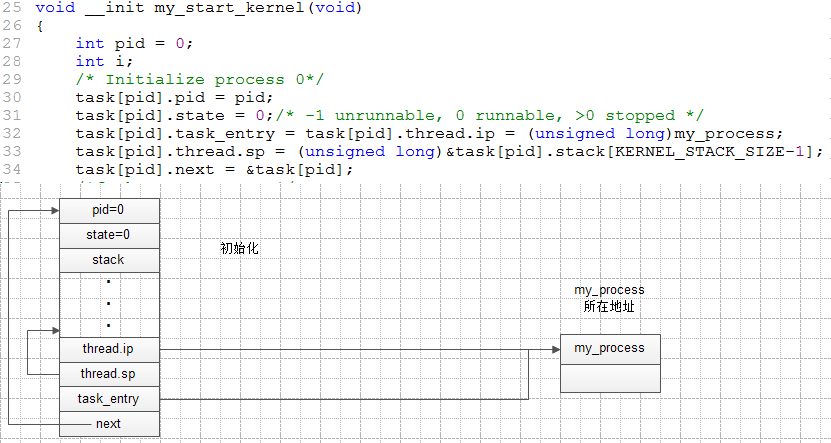一个简单的时间片轮转多道程序内核代码分析
余星光 + 原创作品转载请注明出处 + 《Linux内核分析》MOOC课程http://mooc.study.163.com/course/USTC-1000029000
一、准备工作
可以在实验楼中直接进行,实验环境是已经配好的;
或者在自己的Linux系统中配置环境,步骤如下:
+ sudo apt-get install qemu # install QEMU + sudo ln -s /usr/bin/qemu-system-i386 /usr/bin/qemu + wget https://www.kernel.org/pub/linux/kernel/v3.x/linux-3.9.4.tar.xz # download [Linux Kernel 3.9.4 source code](https://www.kernel.org/pub/linux/kernel/v3.x/linux-3.9.4.tar.xz) + wget https://raw.github.com/mengning/mykernel/master/mykernel_for_linux3.9.4sc.patch # download [mykernel_for_linux3.9.4sc.patch](https://raw.github.com/mengning/mykernel/master/mykernel_for_linux3.9.4sc.patch) + xz -d linux-3.9.4.tar.xz + tar -xvf linux-3.9.4.tar + cd linux-3.9.4 + patch -p1 < ../mykernel_for_linux3.9.4sc.patch + make allnoconfig + make + qemu -kernel arch/x86/boot/bzImage 从qemu窗口中您可以看到my_start_kernel在执行,同时my_timer_handler时钟中断处理程序周期性执行。 + cd mykernel 您可以看到qemu窗口输出的内容的代码mymain.c和myinterrupt.c + 当前有一个CPU执行C代码的上下文环境,同时具有中断处理程序的上下文环境,我们初始化好了系统环境。 + 您只要在mymain.c基础上继续写进程描述PCB和进程链表管理等代码,在myinterrupt.c的基础上完成进程切换代码,一个可运行的小OS kernel就完成了。 + start to write your own OS kernel,enjoy it!
(1)从这里获取实验用的源代码,https://github.com/mengning/mykernel,获取mypcb.h、myinterrupt.c和mymain.c这三个文件;
(2)在虚拟机环境中,将这三个文件拷贝到mykernel目录下,即覆盖之前的myinterrupt.c和mymain.c,并添加mypcb.h文件;
(3)回到linux-3.9.4目录下,使用下面的命令编译、运行
#make allnoconfig #make #qemu -kernel arch/x86/boot/bzImage
运行效果如下:
三、源码分析
我们主要对mypcb.h、myinterrupt.c和mymain.c这三个文件进行分析。
mypcb.h
/*
* linux/mykernel/mypcb.h
*
* Kernel internal PCB types
*
* Copyright (C) 2013 Mengning
*
*/
#define MAX_TASK_NUM 4
#define KERNEL_STACK_SIZE 1024*8
/* CPU-specific state of this task */
struct Thread {
unsigned long ip;
unsigned long sp;
};
typedef struct PCB{
int pid;
volatile long state; /* -1 unrunnable, 0 runnable, >0 stopped */
char stack[KERNEL_STACK_SIZE];
/* CPU-specific state of this task */
struct Thread thread;
unsigned long task_entry;
struct PCB *next;
}tPCB;
void my_schedule(void);
其中,每个PCB对应如下图
然后是mymain.c
#include <linux/types.h>
#include <linux/string.h>
#include <linux/ctype.h>
#include <linux/tty.h>
#include <linux/vmalloc.h>
#include "mypcb.h"
tPCB task[MAX_TASK_NUM];
tPCB * my_current_task = NULL;
volatile int my_need_sched = 0;
void my_process(void);
void __init my_start_kernel(void)
{
int pid = 0;
int i;
/* Initialize process 0*/
task[pid].pid = pid;
task[pid].state = 0;/* -1 unrunnable, 0 runnable, >0 stopped */
task[pid].task_entry = task[pid].thread.ip = (unsigned long)my_process;
task[pid].thread.sp = (unsigned long)&task[pid].stack[KERNEL_STACK_SIZE-1];
task[pid].next = &task[pid];
/*fork more process */
for(i=1;i<MAX_TASK_NUM;i++)
{
memcpy(&task[i],&task[0],sizeof(tPCB));
task[i].pid = i;
task[i].state = -1;
task[i].thread.sp = (unsigned long)&task[i].stack[KERNEL_STACK_SIZE-1];
task[i].next = task[i-1].next;
task[i-1].next = &task[i];
}
/* start process 0 by task[0] */
pid = 0;
my_current_task = &task[pid];
asm volatile(
"movl %1,%%esp\n\t" /* set task[pid].thread.sp to esp */
"pushl %1\n\t" /* push ebp */
"pushl %0\n\t" /* push task[pid].thread.ip */
"ret\n\t" /* pop task[pid].thread.ip to eip */
"popl %%ebp\n\t"
:
: "c" (task[pid].thread.ip),"d" (task[pid].thread.sp) /* input c or d mean %ecx/%edx*/
);
}
void my_process(void)
{
int i = 0;
while(1)
{
i++;
if(i%10000000 == 0)
{
printk(KERN_NOTICE "this is process %d -\n",my_current_task->pid);
if(my_need_sched == 1)
{
my_need_sched = 0;
my_schedule();
}
printk(KERN_NOTICE "this is process %d +\n",my_current_task->pid);
}
}
}
下面对mymain.c中的源码来具体分析
初始化:
从第一个PCB,即task[0]开始执行:
执行上面的代码后,寄存器eip指向my_process函数,计算机开始执行该函数;在my_process函数中有一个死循环,一直打印进程的pid。
myinterrupt.c
/*
* linux/mykernel/myinterrupt.c
*
* Kernel internal my_timer_handler
*
* Copyright (C) 2013 Mengning
*
*/
#include <linux/types.h>
#include <linux/string.h>
#include <linux/ctype.h>
#include <linux/tty.h>
#include <linux/vmalloc.h>
#include "mypcb.h"
extern tPCB task[MAX_TASK_NUM];
extern tPCB * my_current_task;
extern volatile int my_need_sched;
volatile int time_count = 0;
/*
* Called by timer interrupt.
* it runs in the name of current running process,
* so it use kernel stack of current running process
*/
void my_timer_handler(void)
{
#if 1
if(time_count%1000 == 0 && my_need_sched != 1)
{
printk(KERN_NOTICE ">>>my_timer_handler here<<<\n");
my_need_sched = 1;
}
time_count ++ ;
#endif
return;
}
void my_schedule(void)
{
tPCB * next;
tPCB * prev;
if(my_current_task == NULL
|| my_current_task->next == NULL)
{
return;
}
printk(KERN_NOTICE ">>>my_schedule<<<\n");
/* schedule */
next = my_current_task->next;
prev = my_current_task;
if(next->state == 0)/* -1 unrunnable, 0 runnable, >0 stopped */
{
/* switch to next process */
asm volatile(
"pushl %%ebp\n\t" /* save ebp */
"movl %%esp,%0\n\t" /* save esp */
"movl %2,%%esp\n\t" /* restore esp */
"movl $1f,%1\n\t" /* save eip */
"pushl %3\n\t"
"ret\n\t" /* restore eip */
"1:\t" /* next process start here */
"popl %%ebp\n\t"
: "=m" (prev->thread.sp),"=m" (prev->thread.ip)
: "m" (next->thread.sp),"m" (next->thread.ip)
);
my_current_task = next;
printk(KERN_NOTICE ">>>switch %d to %d<<<\n",prev->pid,next->pid);
}
else
{
next->state = 0;
my_current_task = next;
printk(KERN_NOTICE ">>>switch %d to %d<<<\n",prev->pid,next->pid);
/* switch to new process */
asm volatile(
"pushl %%ebp\n\t" /* save ebp */
"movl %%esp,%0\n\t" /* save esp */
"movl %2,%%esp\n\t" /* restore esp */
"movl %2,%%ebp\n\t" /* restore ebp */
"movl $1f,%1\n\t" /* save eip */
"pushl %3\n\t"
"ret\n\t" /* restore eip */
: "=m" (prev->thread.sp),"=m" (prev->thread.ip)
: "m" (next->thread.sp),"m" (next->thread.ip)
);
}
return;
}
当发生始终中断时,执行my_timer_handler函数,每次将全局变量time_count自加1,然后继续执行my_process函数、再中断,直到time_count%1000==0且全局变量my_need_sched!=0时,并打印一串字符,并将my_need_sched置为1,中断函数执行完后,返回到my_process函数,因为my_need_sched=1,开始执行my_schedule。
而对于my_schedule函数的图解如下:
即将执行的环境转移到下一个PCB,然后执行下一个PCB中的my_process函数,如此循环。
上面的代码就实现了一个简单的时间片轮转调度。
四、总结
通过上面的分析,我们知道操作系统支持多道程序的核心就是中断机制。

